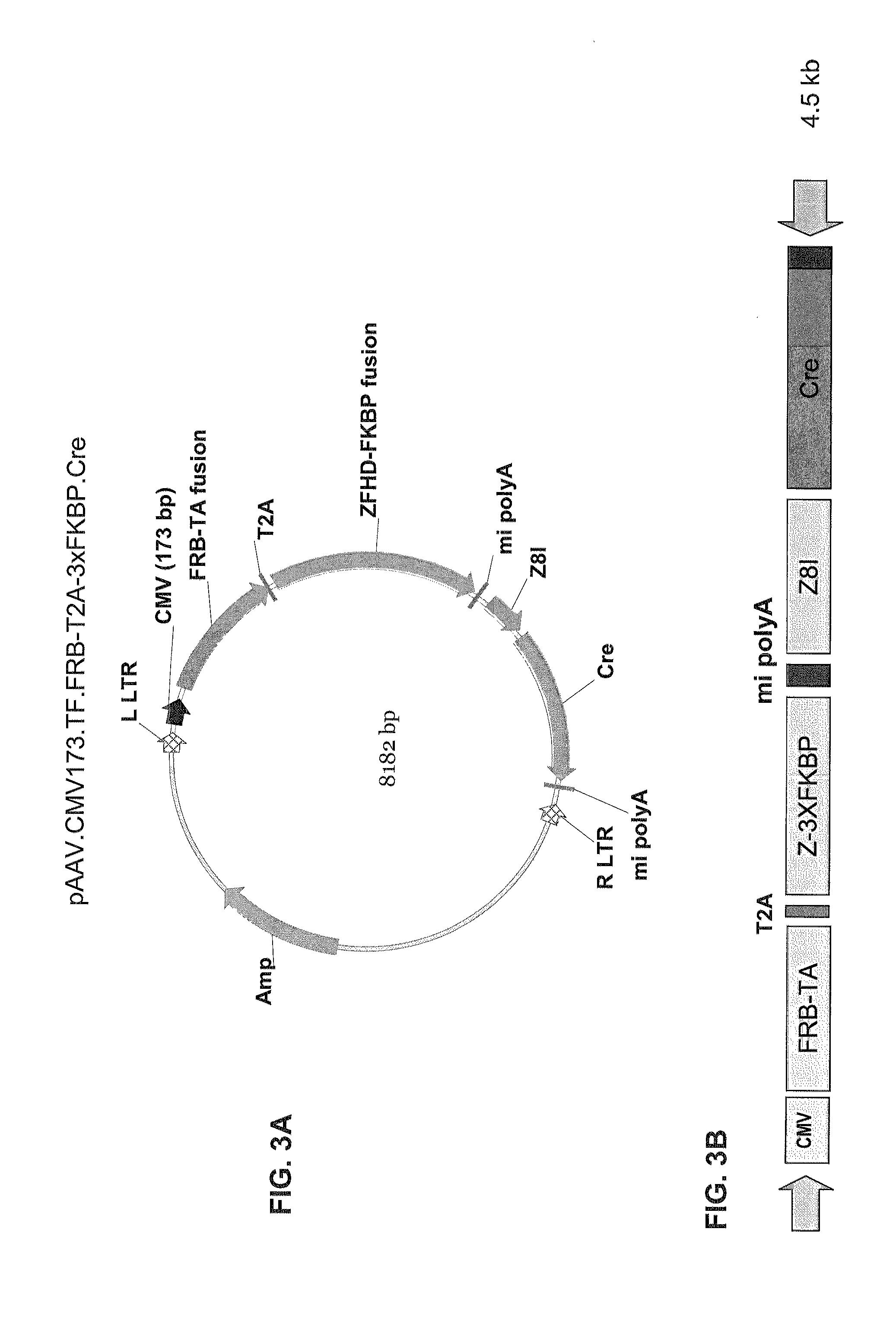Pharmacologically induced transgene ablation system
- Summary
- Abstract
- Description
- Claims
- Application Information
AI Technical Summary
Benefits of technology
Problems solved by technology
Method used
Image
Examples
example 1
6. EXAMPLE 1
Manufacturing of Recombinant AAV Vectors at Scale
[0256]A high yielding, recombinant AAV production process based upon poly-ethylenimine (PEI)-mediated transfection of mammalian cells and iodixanol gradient centrifugation of concentrated culture supernatant. AAV vectors produced with the new process demonstrate equivalent or better transduction both in vitro and in vivo when compared to small scale, cesium chloride (CsCl) gradient-purified vectors. In addition, the iodixanol gradient purification process described effectively separates functional vector particles from empty capsids, a desirable property for reducing toxicity and unwanted immune responses during pre-clinical studies.
[0257]Recently it was observed that, in contrast to AAV2, most other AAV serotypes are primarily released into the media of calcium phosphate-transfected production cultures and not retained in the cell lysate (Vandenberghe, L. H., Lock, M., Xiao, R., Lin, J., Korn, M., and Wilson, J. M. 2010. ...
example 2
7. EXAMPLE 2
Cesium Purification of AAV Vectors
[0293]This example describes a new procedure for cesium chloride (CsCl) purification of AAV vectors from transfected cell pellets.
Day 1—Pellet Processing and CsCl Spin
[0294]1) Lysate Preparation[0295]Thaw cells from −80° C. freezer for 15 minutes at 37° C.[0296]Resuspend the cell pellet in ˜20 mL of Resuspension Buffer 1(50 mM Tris, pH 8.0, 2 mM MgCl) for 40 plates of cells and for a final volume of 20 mL, and place on ice.[0297]Freeze / thaw 3 times (dry ice and ethanol bath / 37° C. water bath).[0298]Add 100 μL of Benzonase (250 U / mL) per prep and invert gently, incubate the samples at 37° C. for 20 minutes, inverting the tube every 5 min.[0299]Add 6 mL of 5M NaCl to bring the final salt concentration to 1 M. Mix.[0300]Spin at 8,000 rpm for 15 min at 4° C. in Sorval centrifuge. Note: Ensure the Sorval is clean. After centrifugation, sterilize tube with 70% before proceeding further. Transfer supernatant to a new tube.[0301]Spin again at 8,...
example 3
8. EXAMPLE 3
DNA Constructs for Preparation of PITA AAV Vectors
[0346]The invention is illustrated by Examples 3-5, which demonstrate the tight regulation of ablator expression using rapamycin, to dimerize transcription factor domains that induce expression of Cre recombinase; and the successful inducible ablation of a transgene containing Cre recognition sites (loxP) in cells. The tight regulation of expression of the ablator is demonstrated in animal models.
[0347]The following are examples of DNA constructs DNA constructs and their use to generate replication-defective AAV vectors for use in accordance with the PITA system of the invention is illustrated in the examples below.
[0348]8.1. Constructs Encoding a Dimerizable Transcription Factor Domain Unit and an Ablation Unit
[0349]FIGS. 1A-B through FIG. 5B are diagrams of the following DNA constructs that can be used to generate AAV vectors that encode a dimerizable transcription factor domain unit and an ablation unit: (1) pAAV.CMV.T...
PUM
| Property | Measurement | Unit |
|---|---|---|
| molecular weight | aaaaa | aaaaa |
| body weight | aaaaa | aaaaa |
| body weight | aaaaa | aaaaa |
Abstract
Description
Claims
Application Information
 Login to View More
Login to View More - R&D
- Intellectual Property
- Life Sciences
- Materials
- Tech Scout
- Unparalleled Data Quality
- Higher Quality Content
- 60% Fewer Hallucinations
Browse by: Latest US Patents, China's latest patents, Technical Efficacy Thesaurus, Application Domain, Technology Topic, Popular Technical Reports.
© 2025 PatSnap. All rights reserved.Legal|Privacy policy|Modern Slavery Act Transparency Statement|Sitemap|About US| Contact US: help@patsnap.com



